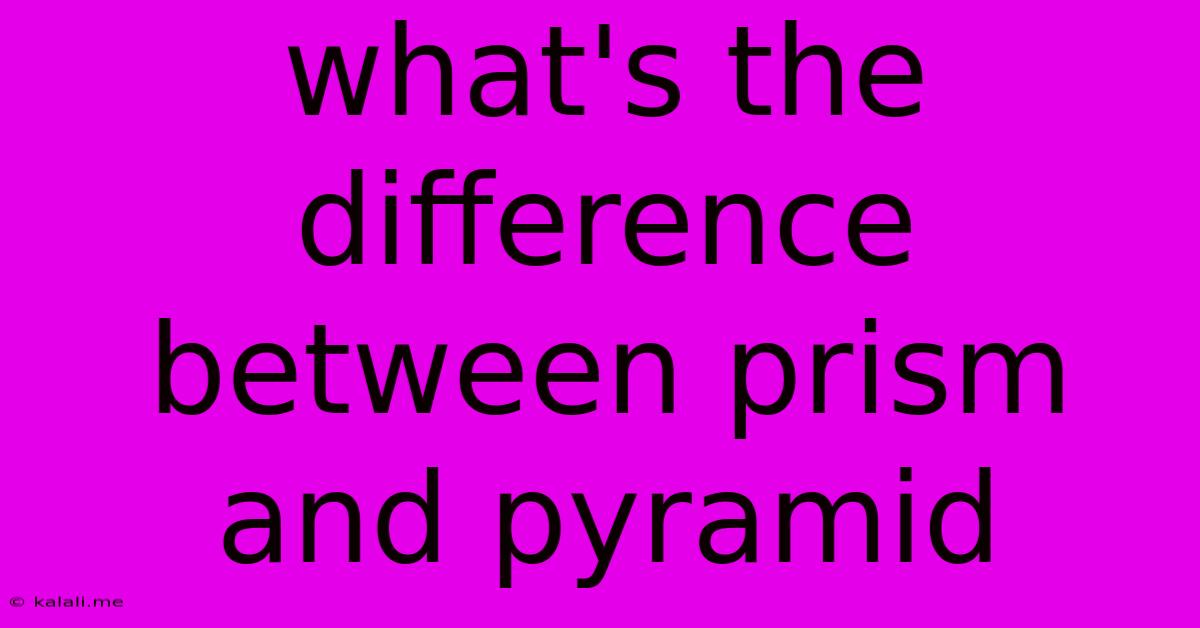What's The Difference Between Prism And Pyramid
Kalali
Jun 12, 2025 · 3 min read

Table of Contents
Prisms vs. Pyramids: Understanding the Differences in 3D Geometry
This article explores the key differences between prisms and pyramids, two fundamental three-dimensional shapes in geometry. Understanding their distinct characteristics is crucial for anyone studying geometry, from students to enthusiasts. We'll delve into their defining features, exploring their bases, faces, edges, and vertices to clarify any confusion. By the end, you'll be able to confidently differentiate between these geometric solids.
What is a Prism?
A prism is a three-dimensional solid with two parallel and congruent polygonal bases. These bases are connected by lateral faces that are parallelograms. Imagine taking a polygon and extending it straight upwards or outwards to create a solid shape; that's essentially a prism. The type of prism is determined by the shape of its base. For instance, a triangular prism has triangular bases, a rectangular prism has rectangular bases, and so on. Key characteristics of a prism include:
- Two congruent and parallel bases: These are identical polygons located on opposite ends of the prism.
- Lateral faces that are parallelograms: These connect the two bases. The number of lateral faces equals the number of sides of the base.
- Consistent cross-section: If you were to slice the prism parallel to the bases, the cross-section would be identical to the bases.
Examples of Prisms:
- Rectangular Prism: Think of a typical box or brick.
- Triangular Prism: Imagine a triangular piece of wood extended lengthwise.
- Pentagonal Prism: A prism with pentagonal bases.
What is a Pyramid?
A pyramid, unlike a prism, has only one base, which is a polygon. From this base, triangular faces converge at a single point called the apex. The apex is directly above (or below) the center of the base, depending on the orientation. Similar to prisms, the type of pyramid is determined by the shape of its base. A square pyramid has a square base, a triangular pyramid has a triangular base, and so on. Key characteristics include:
- One polygonal base: This is the bottom polygon of the pyramid.
- Triangular lateral faces: These faces connect the base to the apex. The number of triangular faces equals the number of sides of the base.
- Single apex: This is the point where all the triangular faces meet.
Examples of Pyramids:
- Square Pyramid: The classic Egyptian pyramid shape.
- Triangular Pyramid (Tetrahedron): A pyramid with a triangular base and three triangular faces.
- Pentagonal Pyramid: A pyramid with a pentagonal base.
Key Differences Summarized:
| Feature | Prism | Pyramid |
|---|---|---|
| Number of Bases | Two congruent and parallel bases | One base |
| Lateral Faces | Parallelograms | Triangles |
| Apex | No apex | One apex |
| Cross-Section | Consistent throughout (parallel to base) | Varies, generally decreasing in size towards the apex |
Conclusion:
While both prisms and pyramids are three-dimensional geometric shapes, their fundamental structures differ significantly. Understanding the differences in their bases, lateral faces, and overall shapes is crucial for grasping basic geometric concepts. By remembering the defining characteristics outlined above, you can confidently distinguish between a prism and a pyramid in any context.
Latest Posts
Latest Posts
-
Which Of The Following Is True Of A Scientific Theory
Jun 13, 2025
-
Moment Of Inertia For A Triangle
Jun 13, 2025
-
How Many Watts Is 1 Horsepower
Jun 13, 2025
-
Voice Sounds Are Produced By The
Jun 13, 2025
-
How Do You Find The Zeros Of A Cubic Function
Jun 13, 2025
Related Post
Thank you for visiting our website which covers about What's The Difference Between Prism And Pyramid . We hope the information provided has been useful to you. Feel free to contact us if you have any questions or need further assistance. See you next time and don't miss to bookmark.